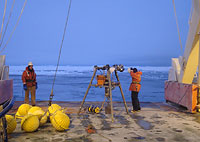

 | |||||||||||||||||||
|
|
Journals 2008/2009Roy Arezzo
July 17, 2008 Day 3 at Station G: Still in the south and still surrounded by gray-white ice. We have been drifting in a two-mile area and moving into position as needed for various deployments. The calm of a ship on ice makes science operations a lot smoother and we sometimes forget we are at sea. I was awakened at what seemed an early hour to a ringing phone; I did not know I had a phone. It was a call to rush down and video tape the deployment of the first Time-lapse Camera (TLC). It was clear and sunny and the excitement of the spectator crowd that had gathered was starting to melt the snow on deck. Many of us had worked on the system at some point over the last few days and countless hours of programming, assembling and refitting to make this moment a reality. I was proud to be witnessing this event and found myself thinking ahead to reports from the next cruise on the secrets from the deep blue. The TLC is equipped with strobe and 35 mm digital lens powered to take deepsea images of a three square meter area of seafloor. An impressive battery pack will keep the camera running for seven months. The interval circuit programmed by University of Hawaii scientists snaps an image every 12 hours to show us the build up of sediment over time and what is down there using it.
Attached to the tripod frame on a line is an Acoustic Doppler Current Profiler, which transmits and receives an acoustic message upwards 100 meters. This shows deep sea currents important in understanding the nutrient flow falling from plankton above versus nutrients from continental ice melt and current driven organic matter. In February the team will be back and they will set off a pair of acoustic releases, which if all goes well, will drop the weights from the camera frame and allow the buoyant glass mooring buoys, keeping the camera upright, to float the instrument to the surface. The signal pole will pop up and flash a beacon light and send out a radio signal, allowing the TLC to be located for retrieval. Craig and his team have invested a lot of time and money into the project and they were concerned about the quick rate of decent. We reviewed the video, which showed the mooring sinking at the correct angle and discussed the variables needed for successful imaging. The deployment location was chosen for its flat sea floor and we hope for a soft upright landing and look forward to the camera's return.
Today I saw my first wildlife outside of the petrels that always seem to escort us for transiting. Adelie penguins (Pygosceiis adeliae) standing only about a meter in height were spotted off the starboard side. They were frolicking in ice out at about 100 meters out, waddling away from the ship. Out too far for my camera's range but close enough to see that they actually do slide on their bellies. Every day has looked like Antarctica, today felt like Antarctica. With wind chills at about minus 20° C and scattered snow showers, our weather luck may have run out. I stayed up late after my shift to photograph my starboard back-deck snowman and say goodbye to Station G as we stow our gear for the ride north to Station F.
|
||||||||||||||||||




